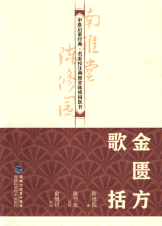金匮方歌括
方书。清陈念祖撰,陈元犀注。六卷。念祖有 《长沙方歌括》 已著录。在编成金匾要略浅注》之后,命其子元犀援《长沙方歌括》体例,将《金匮要略》书中之方依诗歌形式编成此书,为《长沙方歌括》 之姊妹篇。成书于嘉庆十六年 (1811)。全书约八万四千字。卷一,包括痉湿暍、百合狐𧌒阴阳毒病脉证治之方二十四首; 卷二,包括疟、中风历节、血痹虚劳病脉并治之方二十首,附方十首;卷三,包括肺痿肺痈咳嗽上气、奔豚气、胸痹心痛短气、腹满寒疝宿食病脉证治之方三十六首,附方十首; 卷四,包括五脏风寒积聚至水气病脉并治之方四十八首,附方二首; 卷五,包括黄疸至疮痈肠痈浸淫病脉证并治之方三十七首,附方四首; 卷六,包括跌蹶手指臂肿转筋狐疝蚘虫至妇人杂病脉证并治之方四十五首,附方二首。凡二百三十八方。以诗歌形式逐一将《金匮》诸方的主治、药物、剂量、煎服方法简要表述。每方歌括之后所附方解,皆博采前哲之论,宗 《内经》 、《难经》 之旨,参以 《千金》 、《外台》之论,并由元犀等附加按语。阐发透彻,深入浅出,便于习诵。对初学中医者理解、运用 《金匮》之方大有裨益。有同治四年(1865) 文奎堂刊 《南雅堂医书全集十六种》本,一九六三年上海科学技术出版社铅印本。

主要责任者: (清)陈修园;陈竹友
责任方式: 著;点校
出版者: 福建科学技术出版社
出版地: 福州
字数: 119 千字
页码: 1-129
开本: 16
中图分类号: R222.37
装帧: 简装
语种:中
定价:28.00
出版时间:2019-10
丛书多卷书否:是
丛书名:中医启蒙经典.名家校注南雅堂陈修园医书
书目简介:本册工具书是中医启蒙经典.名家校注南雅堂陈修园医书之一,共收录247条词条。